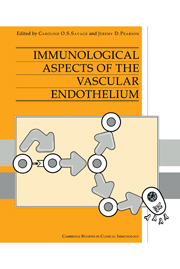Book contents
- Frontmatter
- Contents
- List of contributors
- Preface
- 1 New concepts of mechanisms in autoimmunity
- 2 Regulation of endothelial cell function by cytokines
- 3 Interactions between granulocytes and endothelium
- 4 The regulation of lymphocyte migration by vascular endothelium and its role in the immune response
- 5 Role of the vascular endothelium in immunologically mediated neurological diseases
- 6 The role of the endothelium in systemic lupus erythematosus and Sjögren's syndrome
- 7 The role of the endothelium in rheumatoid arthritis and scleroderma
- 8 The role of the endothelium in systemic vasculitis
- 9 Endothelial involvement in childhood Kawasaki disease
- 10 The role of the endothelium in thrombotic thrombocytopaenic purpura and haemolytic uraemic syndrome
- 11 The immunological role of the endothelium in organ transplantation
- Index
3 - Interactions between granulocytes and endothelium
Published online by Cambridge University Press: 04 August 2010
- Frontmatter
- Contents
- List of contributors
- Preface
- 1 New concepts of mechanisms in autoimmunity
- 2 Regulation of endothelial cell function by cytokines
- 3 Interactions between granulocytes and endothelium
- 4 The regulation of lymphocyte migration by vascular endothelium and its role in the immune response
- 5 Role of the vascular endothelium in immunologically mediated neurological diseases
- 6 The role of the endothelium in systemic lupus erythematosus and Sjögren's syndrome
- 7 The role of the endothelium in rheumatoid arthritis and scleroderma
- 8 The role of the endothelium in systemic vasculitis
- 9 Endothelial involvement in childhood Kawasaki disease
- 10 The role of the endothelium in thrombotic thrombocytopaenic purpura and haemolytic uraemic syndrome
- 11 The immunological role of the endothelium in organ transplantation
- Index
Summary
Introduction
An inflammatory response is associated with alterations in vascular tone and blood flow, enhanced vascular permeability and the extravasation of leukocytes from the blood into the extravascular tissue. It may be beneficial to host defence or detrimental, resulting in an inflammatory disorder. Acute inflammation is of short duration and characterized by an infiltration of neutrophils, whilst a chronic inflammatory response involves the accumulation of lymphocytes, monocytes and, in certain allergic reactions, eosinophils. These processes of leukocyte accumulation in vivo are initiated by the local generation of inflammatory stimuli, and mediated by a series of adhesive interactions between circulating leukocytes and vascular endothelial cells lining post-capillary venules. In recent years, much progress has been made in our understanding of the molecular basis of these adhesive events. This chapter will discuss the mechanisms involved in leukocyte accumulation in vivo, focusing on mechanisms used by neutrophils and eosinophils.
Adhesion molecules
Table 3.1 lists the currently known adhesion molecules believed to be involved in the interaction of neutrophils and eosinophils with endothelial cells. These molecules belong to four structural groups which are discussed below.
Integrins expressed on leukocytes
Integrins are a large family of heterodimeric glycoproteins composed of non-covalently associated α and β subunits. These molecules play an important role in mediating cell-cell interactions and the interaction of cells with extracellular matrix proteins such as fibronectin, vitronectin and laminin (Albelda & Buck, 1990).
- Type
- Chapter
- Information
- Immunological Aspects of the Vascular Endothelium , pp. 43 - 63Publisher: Cambridge University PressPrint publication year: 1995



